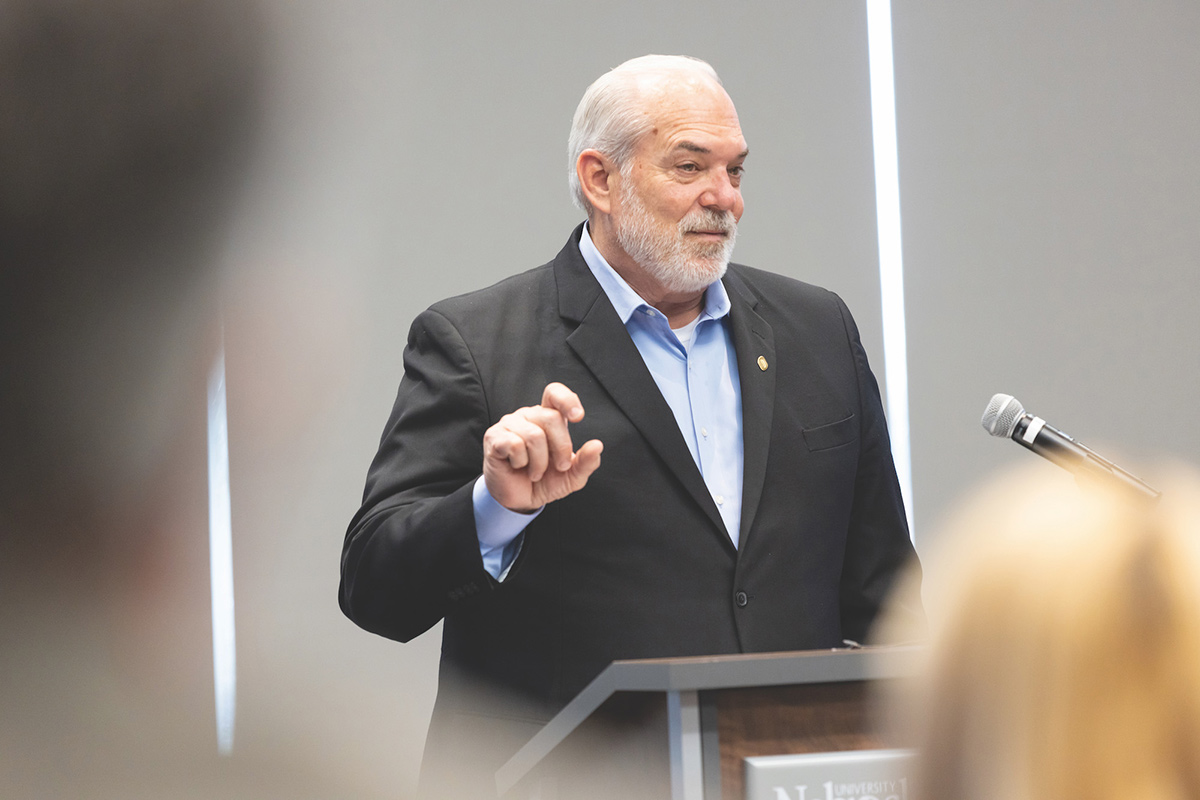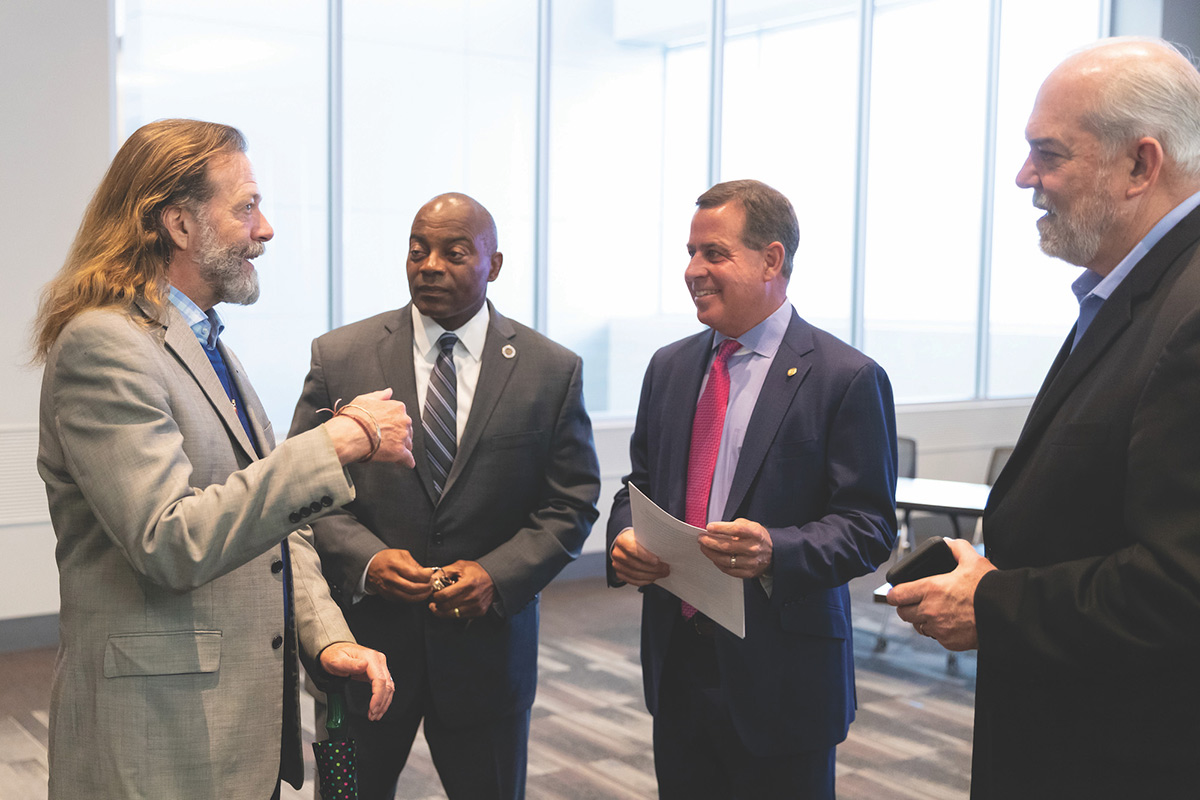UNO Magazine: One Future
David Brown, retired President and CEO of the Greater Omaha Chamber and UNO's first Executive in Residence, provides insight into the university and Omaha's shared future.
- published: 2023/06/08
- contact: Melodae Horst
- email: unonews@unomaha.edu
- search keywords:
- UNO Magazine

From the Spring 2023 UNO Magazine
Economists, human resource professionals and futurists point to the worldwide workforce shortage as a trend that is pushing organizations to think outside the box to solve problems.
David Brown, retired President and CEO of the Greater Omaha Chamber, was named UNO’s first Executive in Residence by Chancellor Joanne Li, Ph.D., CFA, last June. Brown said UNO is in a unique position to serve Omaha by building an infrastructure to bolster collaboration with businesses, create opportunities for students and populate the talent pipeline now and in the future.“A lot of it is about talent,” Brown said.
As the Executive in Residence, Brown helps explore the education and talents currently needed by Omaha employers. With the business community viewed as the customer, and where Brown’s experience and expertise are integral, is facilitating easy and effective collaboration and ensuring UNO is the “provider of choice.”
It’s also about forecasting the future.
“The hope is that we get ahead of the curve so that we don’t have a crisis by the time the business community needs another skill set or intern or type of employee,” Brown said.
This is realized through his role by anticipating and answering business partner questions. He said it must be easy for business leaders to access expertise, systems and processes needed to facilitate talent acquisition.
To start, Brown has introduced difference-makers in the community to UNO deans, addressing issues and roadblocks to ensure students receive internships and job placement.
Keeping Talent in Nebraska
Brown said that although Omaha is a truly remarkable place, there are still people leaving in greater numbers than he would like to see. When Dr. Li talked to Brown about this job in the context of keeping students in the state and engaging businesses, he knew where he wanted to focus.
“We need to make sure UNO students get introduced to the business community as soon as they possibly can,” he said. “We want them to realize the job of their dreams is right here in Nebraska.”
Brown said he capitalizes on his years working at the Chamber as he grapples with an issue that still exists today.
“The biggest gap we have demographically in Omaha is that 18 to 34 age group,” he said. “They are the most mobile and they leave in large numbers.”
If a student goes outside of Nebraska to attend college, he said, data shows they are less likely to return. This is why it is so important to have an attractive option for students to attend a university such as UNO that connects them to equally attractive jobs in Omaha.
Brown said when Omaha loses people to other schools or employment elsewhere between the ages of 23-34, they may not come back until they start having a family.
“Those are 12 very productive years after college that would be better served here with local businesses,” he said.
Strategically, Brown emphasizes that now is the time to develop long-term relationships with local businesses.
Best Case Scenario
Ideally, Brown said, first-year students are introduced to businesses in their field and offered an internship. Students may even complete several internships to find a perfect fit. The goal is that they have a local job offer by the time they graduate. Brown said UNO must confidently say to students, “yes, I can connect you to potential job opportunities.”
“So, that is literally tens of thousands of kids that we have an opportunity to impact, and if we do that,” he said, “then all of a sudden our out migration number shrinks.”
Brown said both businesses and the university have a responsibility to work closer together than they are, “and that is no small feat.”
Navigating Challenges
Brown points to some challenges for UNO students. Traditional “mothership” four-year institutions have students who live on campus and that is their world for four years. The picture of UNO students also includes those who are working 20 to 30 hours per week at a job that isn’t in their chosen career field. They may be taking care of another person at home. Therefore, internships continue to be a challenge to fit into an already full schedule.
The business community is also challenged to provide meaningful, paid opportunities to students. Managing an internship program takes dedicated staff time and expertise as well as appropriate funding. Large organizations may have staff to help recruit interns and elevate their experience, but small and midsize organizations often don’t have the capacity and resources to run a robust internship program.
“We need to help businesses figure out how they make internships work,” Brown said.
Connection and Expansion
Last year, UNO launched Career Connect bringing students and businesses together to create paid internship programs. To date, more than 60 employers have signed up and there are more than 1,200 open internships.

David Brown speaks to business and UNO leaders at the UNO Career Connect launch event.
UNO’s role with the initiative is to show businesses how Career Connect can help them build a talent pipeline. This includes showing businesses how they can grow from offering one internship per year to several. Among the many benefits of using an internship program to power a full-time workforce pipeline are the significant savings over time. This could be one of the greatest services UNO can provide, Brown said.
Making a Difference Now
By the time he officially “retires” from his role at UNO he hopes to have made a difference. “Particularly in the talent space and helping build better communities,” he said.
He said UNO aims for students to have the best access to businesses and jobs of any institution in the state or region.
“Frankly, I think it was an important decision for Dr. Li to make to say, you know what, talent is our thing already, but we are going to make business relationships very, very important here and make it something we can build the university on,” Brown said.
Businesses are thrilled with the notion that there is an institution with a goal to provide them with their future needs, Brown said.
“I think UNO is poised to do something truly remarkable here, and with Dr. Li, with more energy that 10 people put together and a very well-described vision, now is the time to put that into practice,” he said. “That is going to change UNO forever.”
About the UNO Magazine
UNO Magazine is the flagship publication of the University of Nebraska at Omaha (UNO) and is published three times a year as a collaborative effort of UNO, the University of Nebraska Foundation, and the UNO Alumni Association.